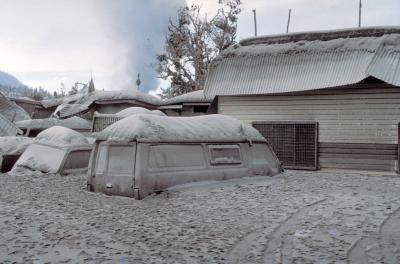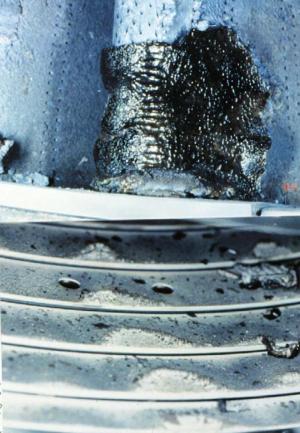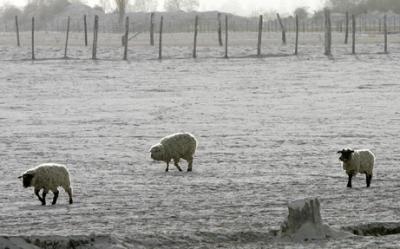 |
| Ash buries cars and buildings after the 1984 eruption of Rabaul, Papua New Guinea. |
 |
| Ash deposits inside the jet engine that encountered the ash cloud from Redoubt Volcano on 15 December 1989. |
Volcanic Ashfall Hazard
Ashfall is the most widespread and
frequent volcanic hazard
USGS Volcano Hazards Program
Explosive eruptions produce ash.
All explosive volcanic eruptions generate tephra,
fragments of rock that are produced when magma or rock
is explosively ejected.
The largest fragments, blocks and bombs (>64 mm, 2.5 inches
diameter), can be expelled with great force but are deposited near the
eruptive vent.
Lapilli-sized material (6-64 mm, 0.24-2.5 inches diameter) can
be carried upward within in a volcanic plume and
downwind in a volcanic cloud, but fall to the ground as the eruption cloud
cools.
The smallest material, volcanic ash (<2
mm diameter) is both easily convected upward within the plume and
carried downwind for very long distances; as it falls out of suspension it can
potentially affect communities and farmland across hundreds, or even thousands,
of square kilometers (miles).
Ash endangers aviation and infrastructure.
Ashfall rarely endangers human lives, but it can have
devastating effects on the things that we rely upon from day to day.
As a result of its fine-grained abrasive character and
widespread distribution by wind, ashfall and volcanic ash clouds are
a major hazard to aviation.
The primary hazard from Alaska volcanoes is ash clouds
impacting aviation and ashfall reaching areas downwind, owing to widespread
dispersal by wind.
Ash fallout to
the ground can pose significant disruption and damage to buildings,
transportation, water and wastewater, power supply, communications equipment,
agriculture, and primary production leading to potentially substantial societal
impacts and costs, even at thicknesses of only a few millimetres or inches.
Additionally, fine grained ash, when ingested can cause
health impacts to humans and animals.
Impacts from ashfall are more complex and multi-faceted than for
any of the other volcanic hazards.
Variabilities include the distance from the eruption source,
orientation and dispersion of the eruption cloud, the amount of ashfall
received, physical and chemical properties of the ash, characteristics of
the receiving environment (such as climate and land use), and the ability of
affected community to adapt to ashfall.
The USGS sponsored Volcanic
Ashfall Impacts Working Group offers resources and guidance for
ashfall preparedness and impact.
 |
| Ash covered the pasture reducing livestock access to feed in Futaleufú following the 2008 Chaitén eruption. |

No comments:
Post a Comment